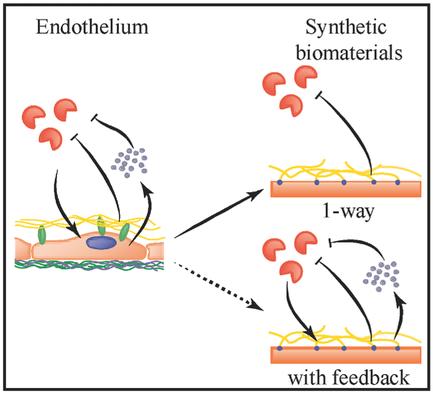当前位置:
X-MOL 学术
›
Adv. Healthcare Mater.
›
论文详情
Our official English website, www.x-mol.net, welcomes your feedback! (Note: you will need to create a separate account there.)
Introduction of Nature's Complexity in Engineered Blood‐compatible Biomaterials
Advanced Healthcare Materials ( IF 10.0 ) Pub Date : 2017-08-25 , DOI: 10.1002/adhm.201700505 Bastiaan D. Ippel 1 , Patricia Y. W. Dankers 1
Advanced Healthcare Materials ( IF 10.0 ) Pub Date : 2017-08-25 , DOI: 10.1002/adhm.201700505 Bastiaan D. Ippel 1 , Patricia Y. W. Dankers 1
Affiliation

|
Biomaterials with excellent blood‐compatibility are needed for applications in vascular replacement therapies, such as vascular grafts, heart valves and stents, and in extracorporeal devices such as hemodialysis machines and blood‐storage bags. The modification of materials that are being used for blood‐contacting devices has advanced from passive surface modifications to the design of more complex, smart biomaterials that respond to relevant stimuli from blood to counteract coagulation. Logically, the main source of inspiration for the design of new biomaterials has been the endogenous endothelium. Endothelial regulation of hemostasis is complex and involves a delicate interplay of structural components and feedback mechanisms. Thus, challenges to develop new strategies for blood‐compatible biomaterials now lie in incorporating true feedback controlled mechanisms that can regulate blood compatibility in a dynamic way. Here, supramolecular material systems are highlighted as they provide a promising platform to introduce dynamic reciprocity, due to their inherent dynamic nature.
中文翻译:

工程血液相容性生物材料的自然复杂性介绍
具有优异血液相容性的生物材料需要用于血管替代疗法(例如血管移植物,心脏瓣膜和支架)以及体外设备(例如血液透析机和储血袋)中。用于血液接触设备的材料的改性已从被动表面改性发展到了更复杂,更智能的生物材料设计,该材料可响应来自血液的相关刺激以抵消凝血。逻辑上,新型生物材料设计的主要灵感来源是内源性内皮。止血的内皮调节很复杂,涉及结构成分和反馈机制之间的微妙相互作用。因此,开发与血液相容的生物材料的新策略所面临的挑战在于,采用能够动态调节血液相容性的真正的反馈控制机制。在这里,超分子材料系统因其固有的动态特性而为提供动态互惠性提供了一个有前途的平台,因此得到了重点介绍。
更新日期:2017-08-25
中文翻译:

工程血液相容性生物材料的自然复杂性介绍
具有优异血液相容性的生物材料需要用于血管替代疗法(例如血管移植物,心脏瓣膜和支架)以及体外设备(例如血液透析机和储血袋)中。用于血液接触设备的材料的改性已从被动表面改性发展到了更复杂,更智能的生物材料设计,该材料可响应来自血液的相关刺激以抵消凝血。逻辑上,新型生物材料设计的主要灵感来源是内源性内皮。止血的内皮调节很复杂,涉及结构成分和反馈机制之间的微妙相互作用。因此,开发与血液相容的生物材料的新策略所面临的挑战在于,采用能够动态调节血液相容性的真正的反馈控制机制。在这里,超分子材料系统因其固有的动态特性而为提供动态互惠性提供了一个有前途的平台,因此得到了重点介绍。

























 京公网安备 11010802027423号
京公网安备 11010802027423号